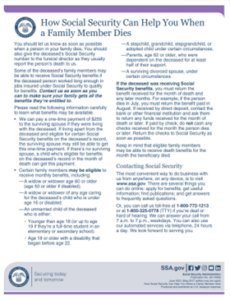Does a Surviving Spouse Continue to Receive Social Security Benefits
The National Academy of Social Insurance provides this information to help those seeking to better understand Social Security, which continues to be a cornerstone of retirement security for American workers and their families. We encourage you to use the information on our site to increase your familiarity with social insurance programs as they currently exist and to envision how they could evolve to meet the needs of a changing world.
Who is entitled to survivors' benefits from Social Security?

How Social Security Can Help You When a Family Member Dies SSA.gov/benefits/survivors
Social Security is a key source of financial security to widowed spouses. About 7.8 million individuals aged 60 and older receive Social Security benefits based, at least in part, on a deceased spouse's work record. These surviving spouse beneficiaries are overwhelmingly women.
These beneficiaries include 3.6 million people who are eligible only as widowed spouses. Another 4.2 million who are entitled to benefits based on their own work records but whose deceased spouses' benefit amounts were higher than their own, will receive higher benefits as individuals (although, as discussed below, lower household total benefits).
How much do widowed spouses receive?
Social Security survivors' benefits are especially important to women (95% of survivor beneficiaries are women), because wives tend to earn less than their husbands, and they also typically outlive their husbands. When a retired worker dies, the surviving spouse receives a benefit equal to the deceased worker's full retirement benefit.
Depending on the widow's or widower's circumstances, however, this benefit may substantially reduce her (his) monthly household income because only one Social Security benefit is now arriving (whichever is higher), not the two benefits that the couple received before the spouse's death. Women who had worked and earned their own Social Security benefits, in particular, may find themselves struggling to meet the rising fixed expenses that come with aging.
Example (husband worked, wife did not): John Smith has a $1,200-a-month retirement benefit, and his wife Jane gets $600 as a 50 percent spousal benefit, so total family income from Social Security is $1,800 a month. When John dies, Jane will get $1,200 a month as her survivor benefit, so her total income is two-thirds of the benefit the Smiths had received as a couple.
Example (husband earned more than wife): Joe Sanchez receives $1,200 a month, and his wife Consuela receives $800 a month, so total family income is $2,000 a month. When Joe dies, Consuela will receive her retirement check plus $400 a month as a widow. Her total benefit will be as much as Joe had been receiving, $1,200 a month, or 60 percent of their former income as a couple.
Example (husband and wife both worked, earned equal amounts): Thom and Cai Nguyen each get benefits based on their individual earnings. Each of them is entitled to $1,200 a month, and total family income is $2,400 a month. When one of them dies, the widowed spouse continues to receive $1,200 a month, but she is not entitled to both benefits. Total monthly family income is thus reduced to $1,200, half of their former income as a couple.
For more information on Social Security and survivor benefits, please visit the Social Security Administration at ssa.gov/benefits/survivors/.
Additional resources:
- This seminal Academy resource is updated annually to reflect the latest Trustees' Report: Social Security Benefits, Finances, and Policy Options: A Primer
- This brief explores four options to reduce widespread poverty among elderly widows, which is driven by a Social Security formula that especially hurts women who had been higher earners: Widows, Poverty, and Social Security Options, Social Security Brief No. 9
- This paper offers a strategy to address the lack of social insurance support for caregiving, which disproportionately penalizes women, especially women of color: Crediting Care in Social Security: A Proposal for an Income Tested Care Credit
How can we help you?
Source: https://www.nasi.org/learn/social-security/social-security-for-widowed-spouses-in-retirement/